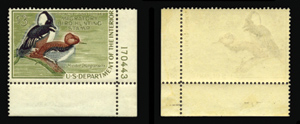 |
10% off on
web orders over $100 |
|
|

|
|
Major error found on 35-year-old U.S. duck stamp
by Bob Dumaine
Some 35 years after it was issued, a major U.S. federal duck stamp error at last has been discovered and authenticated.
 The Philatelic Foundation has issued a certificate identifying a major error on the 1968 $3 issue (Minkus RH35 / Scott RW35), shown here at right. The Philatelic Foundation has issued a certificate identifying a major error on the 1968 $3 issue (Minkus RH35 / Scott RW35), shown here at right.
In 1968, the inscription was changed to read "BUY DUCK STAMPS SAVE WET-LANDS. SEND IN ALL BIRD BANDS. SIGN YOUR DUCK STAMP."
A collector discovered the error while sorting through his collection, when he noticed this single did not have back text like the others.
The stamp was sent to me for examination. I could find nothing to disqualify it as a genuine error, so I submitted it to the Philatelic Foundation for its opinion. The PF issued a certificate stating: "The inscription on the reverse has been omitted, bottom right plate number 170443 single."
Major errors on U.S. federal duck stamps very rarely occur, and those that are found exist in very small quantities. Some are unique. Although the 1968 issue was printed over 34 years ago, only this one example has thus far been discovered.
A maximum of 4 million of each duck stamp are printed annually. Of that figure, approximately 40%, or about 1.4 million, actually are sold in most cases.
Compare that number to postage stamps, which are typically printed in the hundreds of millions, and the chance of finding a duck stamp error is miniscule by contrast.
Two other federal duck stamps have thus far been discovered and certified with the back inscriptions omitted: the 1962 issue (Scott RW29a) and the 1990 issue (Minkus RH57v / Scott RW57a). Detection is difficult, since regummed stamps in these years would not have the inscription, so original gum is vital to establish a genuine error.
Back inscriptions first began being placed on federal duck stamps with the 1946 issue, but the printing was under the gum, directly on the stamp. That changed beginning with the 1954 issue, after which all inscriptions were placed on top of the gum, so any tampering or removing of gum also removed the inscription.
The printing ink is integral to the gum and cannot be removed completely without most of the gum being removed. If removal of only the inscription is attempted, the process will smear into the gum and create a puddle of black muck.
The gum on the discovery example is pristine, except for a minor area of disturbance and a light hinge mark.
Errors such as this are very rare indeed, and value follows that rarity. When such an item becomes available, several serious collectors often bid through a dealer or agent. Owning the only known example can be the competitive difference between a winning exhibit and a losing exhibit.
Thus far, most examples of back inscription problems have been found on $2 and $3 duck stamps. For instance, the 1955 ($2), 1957 ($2) and 1959 ($3) stamps exist with the inscription inverted, and 1962 ($3) and 1968 ($3) stamps have the inscription omitted.
It is interesting to note that most known errors of this type occurred in a 15-year period, until the 1990 $12.50 issue was discovered with the inscription omitted. Except for that, few of these other errors have been found. Perhaps more exist for future lucky collectors to discover.
The Bureau of Engraving and Printing was the printer for the first 68 duck stamps, from 1934 to 2001, and did an outstanding job. It lost the contract for the 2002 stamp, which was awarded to Banknote Corp. of America. The first BCA issue had the dubious distinction of containing the least engraving of any of the 69 stamps issued since 1934. The centering of the 2002 stamps also was of very poor quality compared to other recent duck stamps. I have purchased more than 70 panes of 20 thus far and, after returning many to Kansas City for exchange, often have had the reply, "This is the best we have on hand. Sorry."
I hope future low bidders on federal duck stamps will not mean reduced quality, regardless of who does the printing. The tradition of a top-quality federal stamp should be maintained for the best waterfowl conservation program in the world.
Vaughn Collins, chief of the Duck Stamp Office, advises me that Ashton Potter has won the contract to print the 2003 duck stamp. Let's see how they do. |
|
|



















